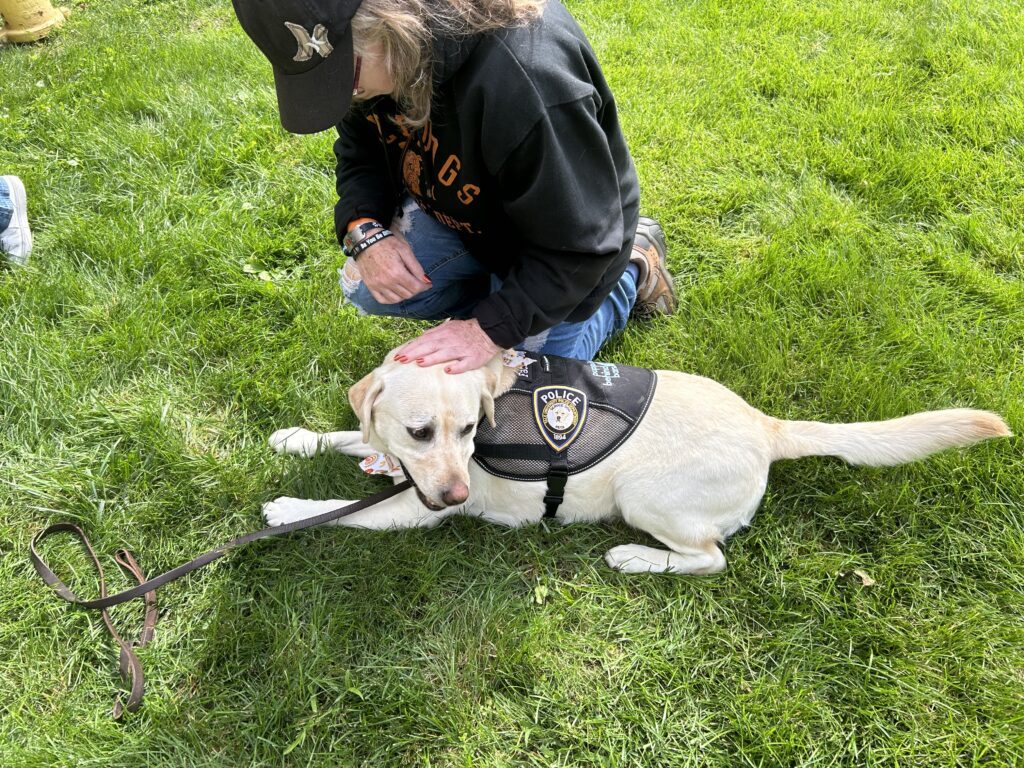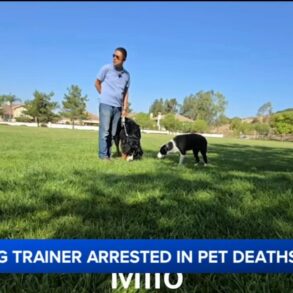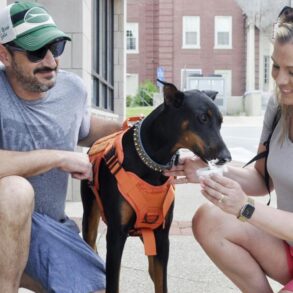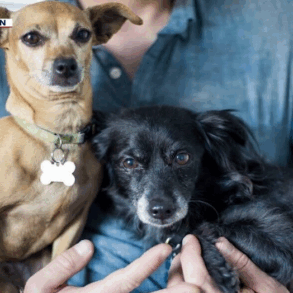
Chloe Edwards, Photography Editor
It took Yale Police Officer Richard Simons 27 years to persuade his department to hire Heidi. As Simons makes plans to retire, the labrador retriever might be leaving with him.
Heidi, a trained support dog, has worked for Yale Public Safety since 2020. Though she was originally hired to help strengthen relationships between officers and the Yale community, her role has expanded to that of a therapeutic service animal, first responder support pup, social media celebrity and companion to Yale’s official canine mascot, Handsome Dan. Trained as her handler, Simons spends his days responding to calls for Heidi’s service around Yale, New Haven and surrounding towns.
But with a new police union contract on the horizon, Simons — who has worked as a YPD officer for over three decades — is planning to retire. When he leaves, the YPD has no plans to continue Team Heidi, the program Simons built.
“I’m not saying that Heidi is the best thing since sliced bread, but close,” Simons said. “Because I love her, and because this was an idea that turned into a dream, and now is my legacy.”
In April, after learning about Simons’ plans to retire, students and community members involved in Heidi’s programming reached out to the Yale Police Department and Yale Public Safety inquiring about the future of the program. YPD and YPS did not respond to these emails. The University also did not respond to the News’ requests for comment for this story.
“Bridging the gap” between students, police
When Officer Simons first joined the Yale Police Department in 1993, he was assigned to Branford and Saybrook colleges as a community-based officer, tasked with interacting with students and serving as their liaison to the department. He noticed, however, that students were reluctant to talk to him when he was in uniform.
One day, Simons got permission to bring his two Rottweiler puppies to work.
“I brought the dogs in, and they were an instant hit,” he recounted. “Everyone knew who I was. Everybody wanted me to bring the dogs back. So I went to my chief’s office and I said, you know, this is an idea. I think this can bridge the gap between the students and the police department.”
But even after several presentations on how a dog could benefit community-officer relations, department leadership was not convinced. It wasn’t until the spring of 2020 that Ronnell Higgins and Anthony Campbell, then the YPD chief and assistant chief of police, accepted Simons’ proposal for a department facilities dog.
After researching potential avenues for purchasing a pet, Simons settled on Puppies Behind Bars, a non-profit organization that allows incarcerated individuals to train canines as service dogs for veterans and first responders, facilities dogs for law enforcement departments or explosive-detection dogs.
Gloria Gilbert Stoga, the founder of Puppies Behind Bars, met Simons at a facilities dog symposium in New York around March 2020, she recalled. That summer, Simons attended a 14-day training to learn how to handle Heidi and her 40 to 60 commands. Though the trainings are usually held in a prison, so that the dog’s original trainer can interact with its new handler, Simons was trained remotely due to the COVID-19 pandemic.
In September 2020, Heidi took her first steps onto campus.



“Heidi plays a couple of roles,” Stoga said. “One is to help with community-officer relations. Two is to help with stress and mental health issues with students. And then three is to help with stress and mental health issues with officers.”
Stoga said that she has not heard of plans to replace Heidi.
Since being appointed as Heidi’s handler, Simons has responded to calls for Heidi to provide support for individuals in need. Many of these calls have taken him off of Yale’s campus — to a school grappling with student death in Hamden, a pediatric burn victim in Bridgeport and survivors of sexual assault testifying against perpetrators in court, Simons said.
Simons said that he feels “blessed and lucky” that his chief allowed him to do so much work outside of the immediate Yale community. He added that his work off campus benefits the University too, as it “makes Yale look good.”
By the time Simons succeeded in bringing Heidi to Yale, he knew that he would soon retire. He initially planned to onboard another officer to take over as a service dog handler.
Because — at five years old — Heidi is young, Simons still plans to continue providing support to nearby communities with Heidi, even if there is no place for him to do so at Yale.
“The good thing about Heidi being as popular as she is, she’s probably one of the top dogs of her type in New England,” Simons said, pointing to Heidi’s large social media following. “She is very visible.”
Community effort, community loss
Margaret Kuo SOM ’25 met Heidi and Simons in September 2023, when Heidi participated in orientation programming at the School of Management, where Kuo is a student.
After Simons mentioned to Kuo that his son had been encouraging him to expand Heidi’s reach over social media, Kuo volunteered to help. She now works for a couple of hours each week, making Tik Tok videos and Instagram Reels showcasing Heidi’s activities and the services she provides to the Yale community.
When Kuo originally learned that Simons planned to retire from the police department, she thought Simons — and Heidi — would be transferred to a civilian agency at the University to continue their work in mental health and student services.
But after hearing that the University intended to terminate Heidi’s program, Kuo and other students sent “at least 20” emails to Duane Lovello, the head of Yale Public Safety, and other administrators. Many of the emails, obtained by the News, share personal stories about Heidi’s positive impact during times of stress.
Corinne Coia, Yale’s student well-being director, shared that Heidi has been a “warm and caring addition” to programming at the Good Life Center, a University wellness initiative.
“Students always share with us that seeing Heidi and getting to engage with her is the highlight of their day,” Coia wrote. “Heidi will be missed but we are so excited that she will now get to relax, retire, and hopefully go on lots of slow mindful walks.”
Ella King ’28, a student who has post-traumatic stress disorder, told the News that she emails Simons her schedule each week, and he finds time for her to meet with Heidi. Before coming to Yale, King had not worked with therapy dogs, but she finds her informal meetings with Heidi to be “extraordinarily helpful.”
Pam Hartigan, a recently retired resident of Colchester, drove out to New Haven on Tuesday to attend an event in front of Yale Health with Heidi and police department dogs from around the area — many from Puppies Behind Bars. Hartigan is a survivor of a heart condition and says that being around dogs is beneficial for her health, especially after her own labrador retriever passed away. Hartigan has seen Heidi at canine events around the county.
“I love Heidi, she’s a savior dog. She brings people together,” Hartigan said. If Yale terminates the program, “I’ll be devastated,” Hartigan continued. “Rich worked so hard all these years. They better keep it going.”
Heidi also has a regular presence on the medical campus, where she greets students after their first time in anatomy lab, where students practice skills on cadavers, according to Simons.
Students get to spend time with Heidi after their anatomy exams, Omar Qureshi ’20 MED ’26 told the News. Exams can be particularly uncomfortable, Qureshi explained, because students must work in a room with multiple cadavers.
“Heidi’s pretty hard to miss,” Qureshi said. “You walk out and she’s waiting for you. It makes you happy. Just seeing her there is like a guaranteed dopamine hit, just a guaranteed moment of joy.”
Qureshi said that Heidi had a meaningful presence on the medical campus during difficult periods for students, such as after a student suicide last year. He described Heidi as “very therapeutic” and said that he was sad to hear the program would not continue.
Acquiring Heidi in 2020 made the YPD the first Ivy League campus police department to have a facilities dog. Public safety departments at Harvard University, Brown University and Princeton University, as well as municipal and campus police forces across Connecticut, have since hired service dogs.
“It would be super sad if we lost Heidi and all these other schools still had these amazing programs that Officer Rich inspired,” Kuo said.
Simons is a former president of the Yale Police Benevolent Association, the union of YPD officers and detectives.
This post was originally published on this site be sure to check out more of their content.













































